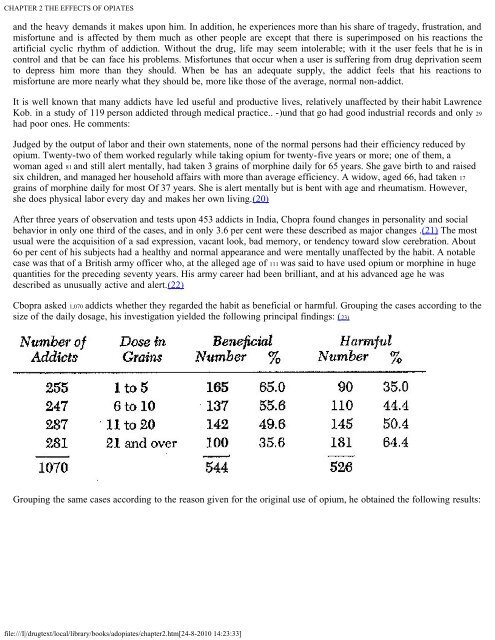Addiction and Opiates
Addiction and Opiates
Addiction and Opiates
You also want an ePaper? Increase the reach of your titles
YUMPU automatically turns print PDFs into web optimized ePapers that Google loves.
CHAPTER 2 THE EFFECTS OF OPIATES<br />
<strong>and</strong> the heavy dem<strong>and</strong>s it makes upon him. In addition, he experiences more than his share of tragedy, frustration, <strong>and</strong><br />
misfortune <strong>and</strong> is affected by them much as other people are except that there is superimposed on his reactions the<br />
artificial cyclic rhythm of addiction. Without the drug, life may seem intolerable; with it the user feels that he is in<br />
control <strong>and</strong> that be can face his problems. Misfortunes that occur when a user is suffering from drug deprivation seem<br />
to depress him more than they should. When be has an adequate supply, the addict feels that his reactions to<br />
misfortune are more nearly what they should be, more like those of the average, normal non-addict.<br />
It is well known that many addicts have led useful <strong>and</strong> productive lives, relatively unaffected by their habit Lawrence<br />
Kob. in a study of 119 person addicted through medical practice.. -)und that go had good industrial records <strong>and</strong> only 29<br />
had poor ones. He comments:<br />
Judged by the output of labor <strong>and</strong> their own statements, none of the normal persons had their efficiency reduced by<br />
opium. Twenty-two of them worked regularly while taking opium for twenty-five years or more; one of them, a<br />
woman aged 81 <strong>and</strong> still alert mentally, had taken 3 grains of morphine daily for 65 years. She gave birth to <strong>and</strong> raised<br />
six children, <strong>and</strong> managed her household affairs with more than average efficiency. A widow, aged 66, had taken 17<br />
grains of morphine daily for most Of 37 years. She is alert mentally but is bent with age <strong>and</strong> rheumatism. However,<br />
she does physical labor every day <strong>and</strong> makes her own living.(20)<br />
After three years of observation <strong>and</strong> tests upon 453 addicts in India, Chopra found changes in personality <strong>and</strong> social<br />
behavior in only one third of the cases, <strong>and</strong> in only 3.6 per cent were these described as major changes .(21) The most<br />
usual were the acquisition of a sad expression, vacant look, bad memory, or tendency toward slow cerebration. About<br />
6o per cent of his subjects had a healthy <strong>and</strong> normal appearance <strong>and</strong> were mentally unaffected by the habit. A notable<br />
case was that of a British army officer who, at the alleged age of 111 was said to have used opium or morphine in huge<br />
quantities for the preceding seventy years. His army career had been brilliant, <strong>and</strong> at his advanced age he was<br />
described as unusually active <strong>and</strong> alert.(22)<br />
Cbopra asked 1,070 addicts whether they regarded the habit as beneficial or harmful. Grouping the cases according to the<br />
size of the daily dosage, his investigation yielded the following principal findings: (23)<br />
Grouping the same cases according to the reason given for the original use of opium, he obtained the following results:<br />
file:///I|/drugtext/local/library/books/adopiates/chapter2.htm[24-8-2010 14:23:33]





